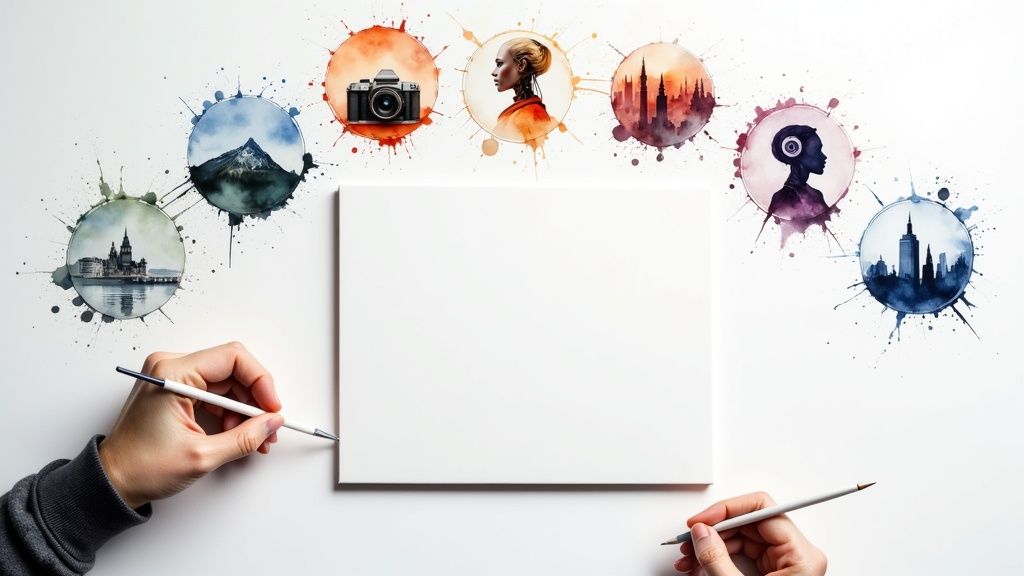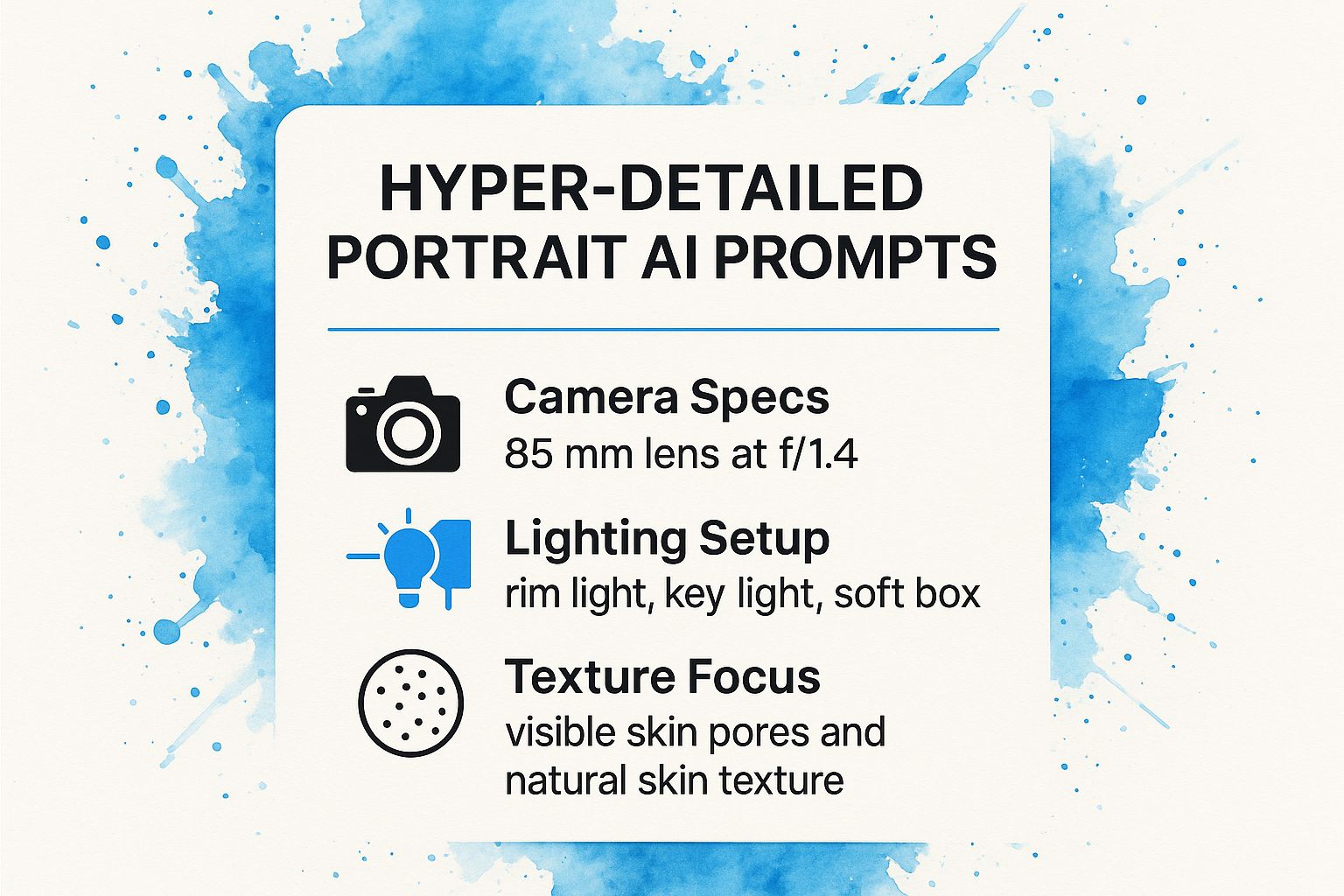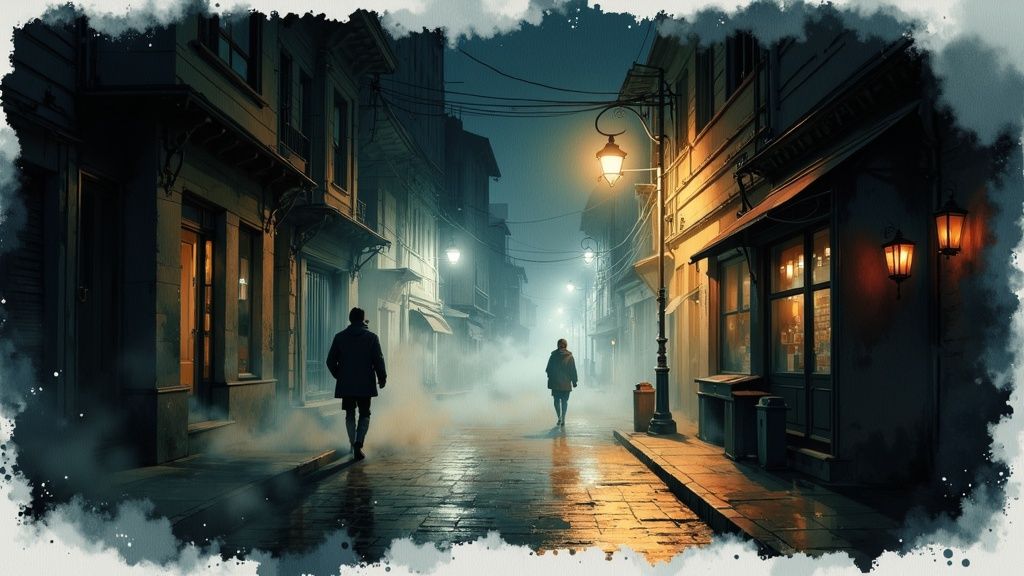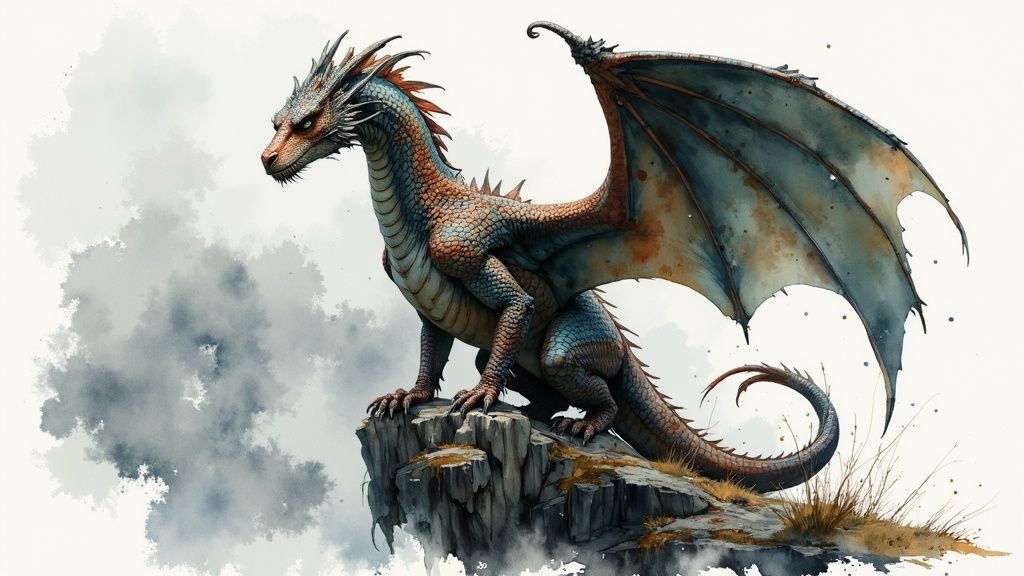7 Best AI Image Prompts to Master in 2025

Welcome to the new frontier of digital creativity, where the right words can conjure any image imaginable. The quality of your AI-generated art doesn't just depend on the model; it hinges on the precision and creativity of your prompts. Many users struggle with generic or chaotic results, but the secret to unlocking consistent, high-impact visuals lies in mastering specific prompt structures. This is where moving beyond simple descriptions becomes essential. For a practical application of this principle, exploring how to start creating AI custom coloring pages from imaginative concepts shows how targeted prompts can transform a niche idea into tangible art.
This guide will reveal the best AI image prompts that professionals use to generate stunning visuals across various styles. We will move beyond basic inputs and delve into the anatomy of powerful prompt engineering. We’ll break down detailed formulas for everything from hyperrealism and cinematic scenes to fantasy art and architectural design.
You will gain actionable templates, practical examples, and expert tips to elevate your creations from simple concepts to portfolio-worthy masterpieces. Whether you're a designer, marketer, or hobbyist, these techniques will fundamentally change how you interact with AI image generators, giving you precise control over your final output.
1. Hyper-Detailed Photorealistic Portrait Prompts
When the goal is to create AI images indistinguishable from professional photography, hyper-detailed photorealistic portrait prompts are the gold standard. These are not your average "portrait of a person" requests; they are complex instructions that borrow heavily from the language of professional photographers. By specifying camera settings, lens types, lighting configurations, and even subtle skin details, you can steer the AI toward creating stunningly lifelike and high-fidelity portraits.
This technique moves beyond simple descriptions to provide the AI with a technical blueprint. Instead of just asking for a "happy woman," you command the AI to render a "Professional headshot of a smiling woman, shot on a Sony a7 IV with an 85mm f/1.4 lens, shallow depth of field, studio lighting with a softbox key light and subtle rim light, natural skin texture with pores visible." This level of detail is one of the reasons these are considered among the best AI image prompts for achieving commercial-quality results.
When to Use This Prompt Style
This approach is ideal when you need images that convey authenticity and professionalism. Common use cases include:
- Professional Branding: Creating unique, high-quality headshots for LinkedIn profiles, corporate websites, or personal portfolios.
- Marketing Materials: Generating realistic visuals for beauty, fashion, or lifestyle brands that require a human touch.
- Creative Projects: Developing character concepts for films, video games, or novels with a specific, realistic aesthetic in mind.
To craft a powerful photorealistic prompt, it's crucial to understand the building blocks that photographers use. The infographic below highlights the essential components for constructing these detailed prompts.

As the visualization shows, combining specific camera, lighting, and texture keywords provides the AI with a precise recipe for realism. Mastering this vocabulary is a key step in advanced prompt creation. For those looking to dive deeper into these techniques, you can explore more about mastering AI prompt engineering on promptden.com. By leveraging these technical specifiers, you gain granular control over the final image, ensuring it aligns perfectly with your creative vision.
2. Cinematic Scene Composition Prompts
To generate images that feel like stills from a blockbuster film, cinematic scene composition prompts are your go-to technique. These prompts focus on storytelling through visual language, borrowing from the lexicon of cinematography to create images with deliberate atmosphere, mood, and narrative depth. By referencing specific directors, film genres, and cinematographic techniques, you can guide the AI to produce dramatic, emotionally resonant scenes.
This method moves beyond a simple description of a scene by adding a layer of directorial intent. Instead of asking for a "detective in an office," you instruct the AI to create a "Film noir detective office, dramatic chiaroscuro lighting, hard shadows cast by window blinds, lingering cigarette smoke, shot on 35mm film with heavy grain, 2.35:1 aspect ratio." This level of detail is why cinematic prompts are considered some of the best AI image prompts for creating immersive, story-driven visuals.

When to Use This Prompt Style
This approach is perfect when you need to evoke a specific emotion or tell a story within a single frame. Key use cases include:
- Concept Art: Developing visual concepts for films, video games, or graphic novels with a strong directorial vision.
- Marketing Campaigns: Creating evocative and atmospheric imagery for book covers, album art, or brand advertisements that require a narrative feel.
- Digital Storytelling: Generating powerful visuals for social media content, blog posts, or presentations that aim to capture an audience's imagination.
Crafting an effective cinematic prompt involves thinking like a director of photography. You need to combine elements of lighting, composition, color, and texture to build a cohesive world. The most impactful prompts often specify a director’s signature style, such as the meticulous symmetry of Wes Anderson or the grand-scale realism of Denis Villeneuve. By specifying details like lens type (anamorphic), film stock (Kodak Portra 400), and color grading (teal and orange), you gain precise control over the image's final look and feel, ensuring it aligns perfectly with your narrative goals. You can explore a wide variety of cinematic prompts on promptden.com to see more examples.
3. Fantasy Art and Worldbuilding Prompts
To bring imaginary realms to life, fantasy art and worldbuilding prompts are the key. These prompts are not simple requests for a "dragon" or "castle"; they are intricate narratives that weave together mythology, literature, and established fantasy aesthetics to construct entire scenes. By combining elements like mystical creatures, enchanted landscapes, and specific character archetypes, you can guide the AI to generate deeply immersive and visually stunning fantasy artwork.
This technique is about building a cohesive vision, much like a concept artist or author. Instead of just asking for an "elf," you provide the AI with a rich backstory: "Digital painting of a stoic wood elf archer with silver hair, perched on an ancient moss-covered tree branch overlooking a misty, enchanted forest at dawn, style of Boris Vallejo." This level of narrative detail is what makes these some of the best AI image prompts for creating original and evocative fantasy worlds.

When to Use This Prompt Style
This approach is perfect for projects that require a strong sense of imagination and narrative depth. Common use cases include:
- Tabletop RPGs: Creating unique character portraits, monster designs, or atmospheric location art for Dungeons & Dragons campaigns.
- Creative Inspiration: Generating cover art concepts for fantasy novels or illustrations for short stories.
- Game Development: Prototyping environment concepts, character designs, and magical item illustrations for video games.
To craft an effective fantasy prompt, focus on blending the familiar with the unexpected. Referencing specific sub-genres like dark fantasy, high fantasy, or urban fantasy can set the tone. Mentioning influential artists such as Frank Frazetta provides a clear stylistic direction, giving the AI a solid foundation to build upon. This method transforms the AI from a simple image generator into a co-creator for your fantasy universe.
By mastering this blend of narrative and style, you can produce artwork that feels both classic and original. For those looking to explore this genre further, you can find a wide range of examples and inspiration for fantasy art and worldbuilding prompts on promptden.com. Leveraging these techniques gives you the power to translate the epic worlds in your mind into compelling visual art.
4. Abstract and Surreal Art Prompts
When your creative goal is to break from reality and explore dreamlike, non-representational imagery, abstract and surreal art prompts are your most powerful tool. These prompts are designed to instruct the AI to generate visuals that challenge conventional logic and perception. By referencing iconic art movements, combining impossible elements, and focusing on emotion over realism, you can guide the AI to create truly unique and thought-provoking art pieces.
This technique is less about replicating the world and more about inventing new ones. Instead of a straightforward request like "a forest," you might use a prompt like, "An ethereal forest where the trees are made of liquid light and the ground is a swirling nebula, in the style of Salvador Dalí and digital surrealism." This conceptual approach makes these some of the best AI image prompts for producing works that are rich with symbolism and visual impact.
When to Use This Prompt Style
This prompt style is perfect for projects that require originality and emotional resonance, moving beyond literal interpretations. Common use cases include:
- Conceptual Art: Creating album covers, book illustrations, or fine art prints that convey a specific mood or idea.
- Digital Content: Designing eye-catching social media graphics, blog headers, or website backgrounds that stand out.
- Inspiration and Ideation: Generating unique visual concepts for branding, textile patterns, or abstract design projects.
To construct an effective surreal or abstract prompt, you must think like an artist, focusing on composition, color, and concept. The key is to blend specific artistic references with imaginative, often contradictory, descriptions.
How to Craft Abstract and Surreal Art Prompts
To achieve compelling results, focus on combining conceptual and stylistic keywords. Here are some actionable tips:
- Reference Art Movements: Use terms like Surrealism, Cubism, or Abstract Expressionism to ground the AI in a specific visual language.
- Combine Impossible Elements: Mix contradictory concepts, such as "a clock melting over a frozen desert" or "a city skyline made of musical instruments."
- Use Emotional Descriptors: Incorporate words that evoke feeling, like "a lonely geometric shape," "a joyful explosion of color," or "a serene, impossible architecture."
- Specify Textures and Materials: Add depth by describing surfaces, for instance, "glossy, iridescent metal," "rough, textured canvas," or "translucent, glowing glass."
By using these elements, you provide the AI with a rich set of instructions for building a scene that defies expectations. For those interested in exploring a vast library of artistic styles and prompts, platforms like Midjourney's Community Showcase can be an excellent source of inspiration. Mastering this prompt style unlocks a new level of creative freedom, allowing you to generate art that is limited only by your imagination.
5. Architectural and Environmental Design Prompts
When the objective is to generate breathtaking buildings, interiors, or expansive cityscapes, architectural and environmental design prompts are the essential toolkit. These prompts function as a digital blueprint for AI, translating the principles of architecture and urban planning into instructions for the model. By detailing specific styles, materials, and environmental settings, you can command the AI to construct everything from a cozy, sustainable home to a sprawling futuristic metropolis.
This technique is about more than just describing a building; it's about defining its very essence and context. Instead of a simple "modern house," you instruct the AI to render a "Biophilic modern villa nestled in a coastal cliffside, featuring cantilevered balconies, floor-to-ceiling glass walls, and a green roof, warm afternoon sun casting long shadows, organic architecture inspired by Frank Lloyd Wright." This granular approach is why these are some of the best AI image prompts for creating visually stunning and conceptually rich environmental art.
When to Use This Prompt Style
This prompt style is perfect for projects that require a strong sense of place, structure, and atmosphere. Common use cases include:
- Conceptual Design: Visualizing architectural concepts for client presentations, portfolio pieces, or academic projects.
- Game and Film Environments: Creating detailed world-building art, from fantasy cities to sci-fi habitats.
- Real Estate and Interior Design: Generating inspirational mockups for marketing materials or client mood boards.
To build an effective architectural prompt, it's vital to think like both an architect and a landscape designer. The key is to blend structural details with atmospheric elements. For practical applications in real-world spaces, an AI-powered online interior design tool can help visualize complete transformations.
Crafting the best AI image prompts in this category involves a few core components:
- Architectural Style: Specify a distinct style like Bauhaus, Art Deco, Brutalist, or Parametric.
- Materials: Mention key materials such as polished concrete, reclaimed wood, weathered steel, or translucent glass.
- Environmental Context: Place your structure in a specific setting, for example, urban high-rise, secluded forest cabin, or arid desert landscape.
- Lighting: Define the mood with lighting cues like golden hour sunlight, moody overcast sky, or dramatic architectural uplighting.
By combining these elements, you provide the AI with a comprehensive and clear vision, enabling it to produce complex and evocative architectural imagery that brings your ideas to life.
6. Product Design and Commercial Visualization Prompts
When the goal is to generate clean, professional imagery for e-commerce, advertising, or marketing, product design and commercial visualization prompts are essential. These prompts are crafted to mimic high-end studio photography, focusing on perfect lighting, composition, and material textures to make a product look its absolute best. They are less about artistic expression and more about commercial appeal and clarity.
This technique involves providing the AI with a detailed brief, much like a creative director would give to a photographer. Instead of a simple "photo of a watch," you would specify, "Commercial product shot of a luxury chronograph watch, matte black stainless steel case, sapphire crystal glass with anti-reflective coating, studio lighting with a softbox for gentle highlights, on a minimalist dark gray background, macro shot, hyper-detailed." This level of detail is why these are considered some of the best AI image prompts for generating high-converting commercial assets.
When to Use This Prompt Style
This approach is perfect for creating visuals that need to be polished, persuasive, and ready for commercial use. Common applications include:
- E-commerce Listings: Generating crisp, consistent product photos for Amazon, Shopify, or other online storefronts.
- Advertising Campaigns: Creating mockups for ad banners, social media posts, and print materials that showcase a product in an idealized setting.
- Packaging Design: Visualizing concepts for bottles, boxes, and labels before physical production begins.
- Marketing Content: Producing high-quality food photography for menus or lifestyle shots of fashion accessories for catalogs.
To craft a compelling commercial prompt, it's crucial to think like a product photographer and a brand strategist. Specify the lighting setup (softbox, key light, fill light), the background (white seamless, lifestyle setting), the camera angle (eye-level, top-down shot), and key material properties (glossy plastic, brushed metal, matte finish). Including brand colors and styling elements can further align the output with a specific identity. By mastering this vocabulary, you can generate product imagery that meets professional standards and drives commercial success.
7. Character Design and Concept Art Prompts
When the goal is to bring a fictional character to life, Character Design and Concept Art Prompts are the essential tool. These prompts are meticulously crafted to guide AI in generating unique, visually compelling characters for video games, animation, comics, or novels. They go beyond simple descriptions by detailing personality traits, costume elements, and specific art styles to create a complete visual identity.
This technique transforms abstract ideas into tangible designs. Rather than asking for a "fantasy warrior," you instruct the AI to create a "Full body concept art of a stoic female elven rogue, lean build, wearing dark leather armor with intricate silver filigree, dual-wielding glowing daggers, set against a moonlit forest backdrop, art style of Blizzard Entertainment." This specificity makes them some of the best AI image prompts for developing memorable and visually consistent characters for any creative project.
When to Use This Prompt Style
This approach is perfect for any stage of creative development where visualizing a character is crucial. Common use cases include:
- Pre-production: Generating concept art for main protagonists, antagonists, and supporting characters in games, films, or animation.
- Storytelling: Creating visual references for characters in novels, comics, and graphic novels to ensure consistency and inspire further development.
- Prototyping: Quickly iterating on different character designs for tabletop RPGs, marketing mascots, or personal art projects.
To craft a successful character prompt, you must think like a concept artist, blending visual descriptions with personality cues. Detail the character’s costume, accessories, and any signature props they might carry. Specifying an art style, such as "Pixar-style 3D render," "Japanese anime character sheet," or "gritty comic book ink style," provides the AI with a clear aesthetic framework. Combining these elements allows you to create a detailed blueprint that the AI can use to render a character that perfectly matches your creative vision.
Top 7 AI Image Prompt Types Comparison
| Item | Implementation Complexity 🔄 | Resource Requirements ⚡ | Expected Outcomes 📊 | Ideal Use Cases 💡 | Key Advantages ⭐ |
|---|---|---|---|---|---|
| Hyper-Detailed Photorealistic Portrait Prompts | High – requires technical photography knowledge | High – advanced AI models needed | Highly realistic, magazine-quality portraits | Professional headshots, commercial marketing | Consistent high realism; commercial ready |
| Cinematic Scene Composition Prompts | High – film terminology and style references | Medium-High – detailed style layering | Dramatic, story-driven cinematic scenes | Concept art, storyboarding, genre-specific visuals | Visually compelling storytelling |
| Fantasy Art and Worldbuilding Prompts | Medium – complex but flexible | Medium – creative input essential | Elaborate fantasy worlds and creatures | Gaming, entertainment, fantasy illustration | Unlimited creativity and fan appeal |
| Abstract and Surreal Art Prompts | Medium – abstract concepts, less structured | Low-Medium – emphasis on creativity | Unique, dreamlike and emotional imagery | Artistic expression, contemporary art, therapy | Highly creative, unique outputs |
| Architectural and Environmental Design Prompts | Medium-High – architectural knowledge needed | Medium – style and materials specification | Realistic and speculative architectural designs | Architecture, real estate, interior design | Useful for visualization; design accuracy |
| Product Design and Commercial Visualization Prompts | Medium – commercial styling and lighting | Medium – structured setup for product shots | Clean, brand-consistent product images | E-commerce, advertising, marketing | Cost-effective, rapid prototyping |
| Character Design and Concept Art Prompts | Medium-High – iterative, detailed character traits | Medium – requires customization | Unique, expressive characters | Games, animation, comics, entertainment | High customization; storytelling support |
Beyond the Prompt: Your Next Steps in Creative AI
We have journeyed through a comprehensive collection of some of the best AI image prompts, moving far beyond simple one-line requests. From crafting hyper-detailed photorealistic portraits that capture every nuance of human expression to architecting sprawling fantasy worlds and visualizing sleek commercial products, you now possess a powerful creative arsenal. The core lesson is clear: a truly effective prompt is not a command, but a detailed set of instructions. It is a carefully constructed recipe blending subject, style, context, and technical specifications.
The true power of these prompt structures lies in their modularity. The techniques you learned for cinematic lighting can be applied to architectural renders to create a dramatic mood. The principles of character concept art can inform your approach to creating a unique subject for an abstract piece. The secret to elevating your creations is to think like a director, a photographer, and a designer all at once, borrowing and blending elements to forge something entirely new. Your journey to mastery begins with this spirit of fearless experimentation.
Key Takeaways for Your Creative Toolkit
To truly integrate these concepts into your workflow, focus on these essential takeaways:
- Specificity is Supreme: Vague terms yield generic results. Replace "dark" with "chiaroscuro lighting with deep, dramatic shadows" or "old man" with "an elderly man with deep-set eyes, a weathered face, and a thoughtful expression." Precision is your greatest asset.
- Borrow from Other Disciplines: The most compelling prompts often incorporate the specialized language of other fields. Use photographic terms like
f-stop,shutter speed, andlens type. Invoke cinematic techniques likeDutch angle,three-point lighting, andanamorphic lens flare. - Iterate and Refine: Your first prompt is rarely your last. Treat the initial generation as a sketch. Analyze what worked and what didn't, then refine your prompt by adding, removing, or adjusting parameters. Small changes, like altering a single keyword or adjusting a weight, can lead to dramatically different and improved outcomes.
Your Path Forward: From Learning to Creating
The ultimate goal is to develop your own unique artistic voice through the medium of AI. The prompts provided in this guide are not just templates to copy; they are foundational frameworks for you to build upon. Start by modifying them. Combine a prompt for an abstract style with the subject of a cinematic scene. Use the meticulous detail from product visualization prompts to create a hyper-realistic fantasy creature.
This process of continuous learning and iteration is the key to unlocking the full potential of generative AI. By understanding the underlying structure of what makes the best AI image prompts so effective, you are no longer just a user of a tool. You become a true creator, capable of translating any vision from your imagination into a stunning visual reality. The canvas is infinite, and your next masterpiece is just a well-crafted prompt away.
Ready to discover thousands of expertly crafted prompts or share your own creative formulas with the world? Join the vibrant community at PromptDen, the ultimate marketplace for buying and selling high-quality AI prompts. Explore what's possible and accelerate your creative journey today at PromptDen.